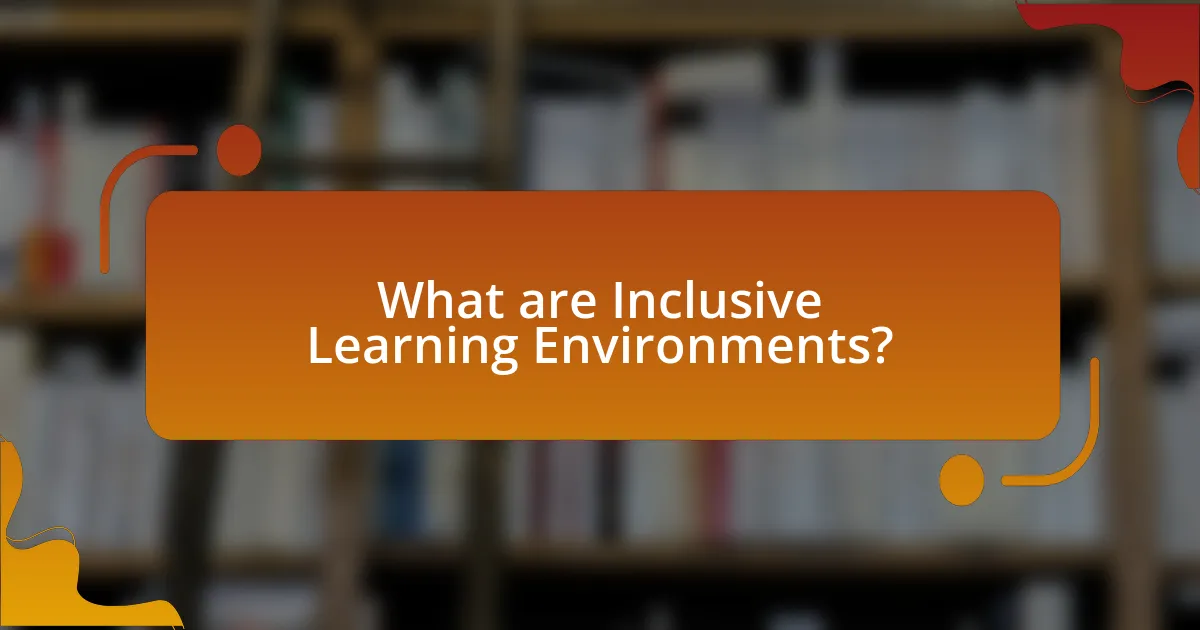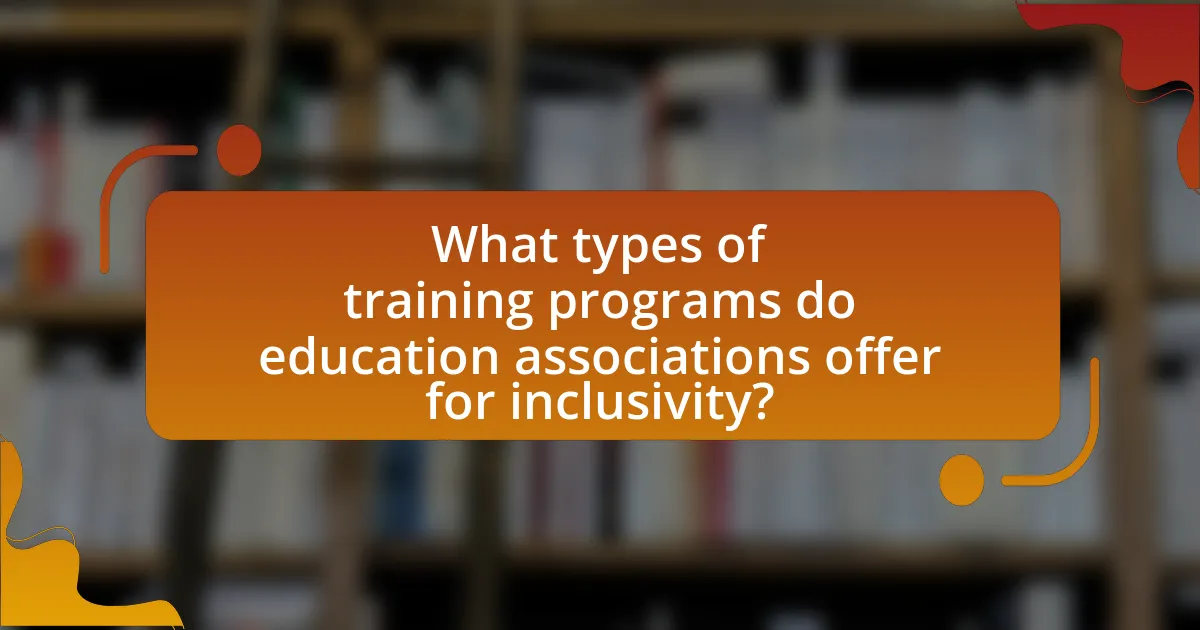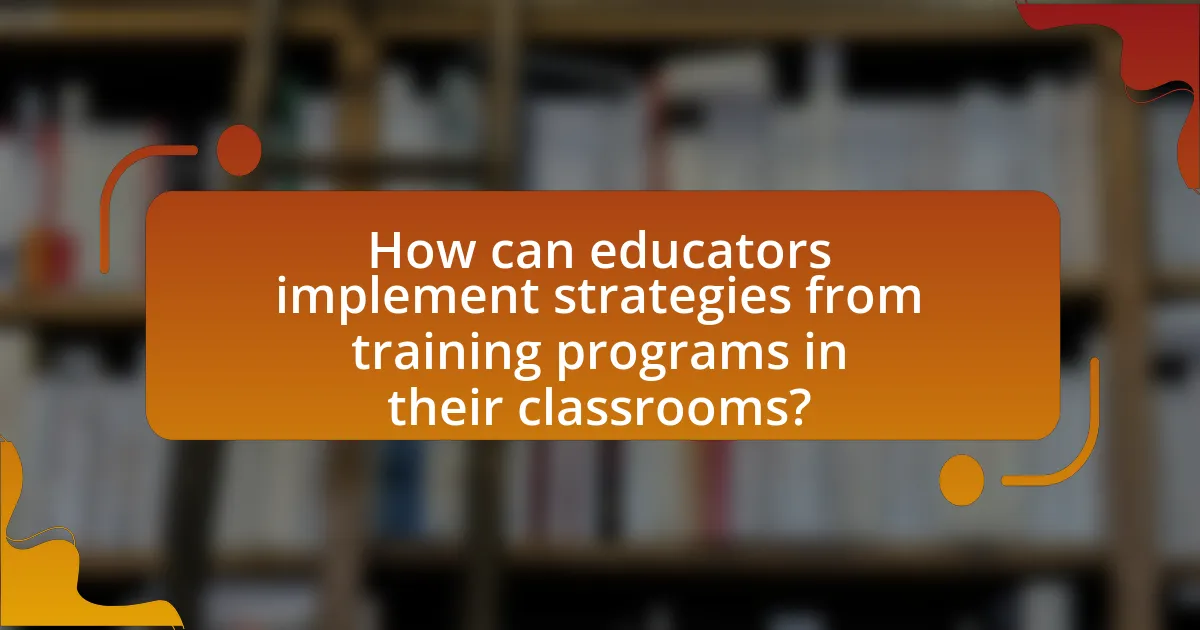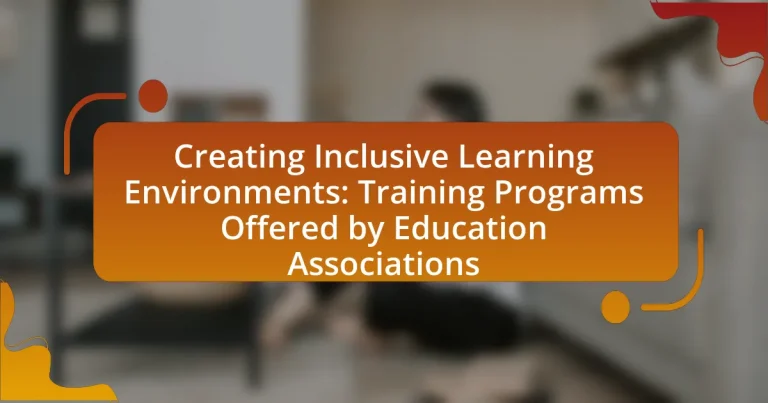Creating inclusive learning environments is essential for accommodating diverse learners in educational settings. This article explores the significance of inclusivity in education, highlighting the benefits for students of varying abilities and backgrounds, as well as the challenges educators face in implementing inclusive practices. It discusses the principles guiding inclusive environments, the role of Universal Design for Learning, and the importance of cultural competence. Additionally, the article examines training programs offered by education associations that equip educators with the necessary skills and strategies to foster inclusivity, addressing common challenges and providing resources for continuous improvement.

What are Inclusive Learning Environments?
Inclusive learning environments are educational settings that accommodate diverse learners by providing equitable access to resources, support, and opportunities for participation. These environments are characterized by their commitment to recognizing and valuing individual differences, including varying abilities, backgrounds, and learning styles. Research indicates that inclusive learning environments enhance student engagement and achievement, as they foster a sense of belonging and community among all learners. For instance, a study published in the “Journal of Special Education” found that inclusive practices lead to improved academic outcomes for students with disabilities, demonstrating the effectiveness of such environments in promoting overall educational success.
Why are Inclusive Learning Environments important in education?
Inclusive learning environments are important in education because they promote equity and accessibility for all students, regardless of their backgrounds or abilities. These environments foster a sense of belonging, which enhances student engagement and motivation. Research indicates that inclusive practices lead to improved academic outcomes; for instance, a study published in the Journal of Special Education found that students in inclusive settings demonstrated higher achievement levels compared to those in segregated environments. Furthermore, inclusive learning environments prepare students for diverse workplaces and communities, equipping them with the social skills necessary to collaborate with individuals from various backgrounds.
How do Inclusive Learning Environments benefit diverse learners?
Inclusive learning environments benefit diverse learners by fostering a sense of belonging and promoting equitable access to education. These environments accommodate various learning styles, cultural backgrounds, and abilities, which enhances engagement and participation among all students. Research indicates that inclusive practices lead to improved academic outcomes; for instance, a study published in the Journal of Special Education found that students in inclusive settings demonstrated higher achievement levels compared to those in segregated classrooms. Additionally, inclusive environments encourage collaboration and social interaction, which are essential for developing critical social skills and reducing stigma associated with disabilities or differences.
What challenges do educators face in creating Inclusive Learning Environments?
Educators face several challenges in creating inclusive learning environments, primarily including diverse student needs, lack of resources, and insufficient training. Diverse student needs encompass varying learning styles, disabilities, and cultural backgrounds, which require tailored instructional strategies. A lack of resources, such as appropriate materials and support staff, hinders the ability to implement inclusive practices effectively. Additionally, insufficient training for educators on inclusive teaching methods limits their preparedness to address these challenges. Research indicates that only 17% of teachers feel adequately trained to support students with disabilities, highlighting the critical need for comprehensive professional development in this area.
What principles guide the creation of Inclusive Learning Environments?
The principles that guide the creation of Inclusive Learning Environments include equity, accessibility, and respect for diversity. Equity ensures that all learners have access to the same educational opportunities, regardless of their backgrounds or abilities. Accessibility involves designing learning spaces and materials that accommodate diverse needs, enabling all students to participate fully. Respect for diversity acknowledges and values the unique perspectives and experiences of each learner, fostering an environment where everyone feels included and supported. These principles are supported by research indicating that inclusive practices enhance educational outcomes and promote a sense of belonging among students.
How does Universal Design for Learning (UDL) apply to inclusivity?
Universal Design for Learning (UDL) enhances inclusivity by providing flexible learning environments that accommodate diverse learner needs. UDL principles advocate for multiple means of engagement, representation, and action, ensuring that all students, regardless of their backgrounds or abilities, can access and participate in the learning process. Research indicates that implementing UDL strategies leads to improved educational outcomes for students with disabilities and those from varied cultural backgrounds, as it promotes personalized learning experiences that cater to individual strengths and challenges.
What role does cultural competence play in Inclusive Learning Environments?
Cultural competence is essential in inclusive learning environments as it enables educators to effectively engage with diverse student populations. By understanding and respecting different cultural backgrounds, educators can tailor their teaching methods to meet the unique needs of all students, fostering a sense of belonging and enhancing academic success. Research indicates that culturally competent teaching practices lead to improved student outcomes, as they promote equity and inclusivity in the classroom. For instance, a study published in the “Journal of Teacher Education” by Villegas and Lucas (2002) emphasizes that teachers who are culturally competent are better equipped to address the varied learning styles and cultural references of their students, ultimately creating a more supportive and effective learning environment.

What types of training programs do education associations offer for inclusivity?
Education associations offer various training programs focused on inclusivity, including workshops on culturally responsive teaching, professional development courses on special education strategies, and seminars addressing implicit bias. These programs aim to equip educators with the skills necessary to create inclusive classrooms that accommodate diverse learning needs. For instance, the National Education Association provides resources and training on Universal Design for Learning, which emphasizes flexible teaching methods to support all students. Additionally, the Association for Supervision and Curriculum Development offers training on equity in education, highlighting the importance of recognizing and addressing systemic barriers to learning.
How do these training programs address the needs of educators?
Training programs offered by education associations address the needs of educators by providing targeted professional development that enhances their skills in creating inclusive learning environments. These programs focus on equipping educators with strategies to accommodate diverse learning styles and needs, thereby fostering an equitable classroom atmosphere. For instance, research indicates that training in differentiated instruction and culturally responsive teaching significantly improves educators’ ability to engage all students effectively. Additionally, these programs often include practical workshops and resources that educators can implement immediately, ensuring that the training is relevant and applicable to their daily teaching practices.
What specific skills are taught in these training programs?
The specific skills taught in training programs focused on creating inclusive learning environments include cultural competency, differentiated instruction, and effective communication strategies. Cultural competency equips educators to understand and respect diverse backgrounds, enhancing their ability to engage all students. Differentiated instruction teaches methods to tailor teaching approaches to meet varied learning needs, ensuring that every student can access the curriculum. Effective communication strategies focus on fostering collaboration among students, families, and educators, which is essential for building a supportive learning community. These skills are critical for promoting inclusivity and equity in educational settings.
How do training programs incorporate feedback from educators?
Training programs incorporate feedback from educators by systematically collecting and analyzing their insights to enhance program effectiveness. This process often includes surveys, focus groups, and interviews, allowing educators to share their experiences and suggestions. For instance, a study by the National Education Association found that 75% of educators reported that their feedback led to significant changes in training content and delivery methods, demonstrating the impact of educator input on program design.
What are the key components of effective training programs for inclusivity?
The key components of effective training programs for inclusivity include comprehensive curriculum design, skilled facilitators, ongoing assessment, and a supportive environment. Comprehensive curriculum design ensures that the content addresses diverse perspectives and experiences, promoting understanding and empathy among participants. Skilled facilitators are essential as they guide discussions, manage group dynamics, and create a safe space for sharing. Ongoing assessment allows for the evaluation of training effectiveness and participant engagement, enabling continuous improvement. A supportive environment fosters open communication and encourages participants to express their thoughts and feelings, which is crucial for building an inclusive culture. These components collectively contribute to the success of inclusivity training programs.
How do these programs ensure ongoing support for educators?
These programs ensure ongoing support for educators through continuous professional development, mentorship opportunities, and access to resources. Continuous professional development includes workshops and training sessions that are regularly updated to reflect current best practices in inclusive education. Mentorship opportunities pair experienced educators with those new to inclusive practices, fostering a supportive community. Additionally, access to resources such as online platforms, teaching materials, and forums allows educators to seek assistance and share experiences, thereby enhancing their teaching effectiveness and confidence in creating inclusive learning environments.
What assessment methods are used to evaluate the effectiveness of these training programs?
Assessment methods used to evaluate the effectiveness of training programs include pre- and post-training assessments, participant feedback surveys, and observational assessments. Pre- and post-training assessments measure knowledge and skill acquisition by comparing participants’ performance before and after the training. Participant feedback surveys gather subjective evaluations of the training experience, allowing for insights into perceived effectiveness and areas for improvement. Observational assessments involve monitoring participants during training to evaluate engagement and application of learned skills in real-time scenarios. These methods collectively provide a comprehensive evaluation of training effectiveness, ensuring that educational associations can refine their programs based on concrete data and participant experiences.

How can educators implement strategies from training programs in their classrooms?
Educators can implement strategies from training programs in their classrooms by integrating evidence-based practices learned during the training into their daily lesson plans and classroom management techniques. For instance, if a training program emphasizes differentiated instruction, educators can tailor their teaching methods to accommodate diverse learning styles and needs, thereby fostering an inclusive environment. Research indicates that such practices enhance student engagement and achievement; a study by Tomlinson (2001) in “How to Differentiate Instruction in Mixed-Ability Classrooms” shows that differentiated instruction leads to improved academic outcomes for all students. Additionally, educators can collaborate with peers to share insights and strategies from the training, creating a supportive network that reinforces the application of these methods in real classroom settings.
What practical strategies can educators use to foster inclusivity?
Educators can foster inclusivity by implementing differentiated instruction, which tailors teaching methods to accommodate diverse learning needs. This approach allows educators to address various learning styles, abilities, and backgrounds, ensuring that all students can engage with the material effectively. Research indicates that differentiated instruction can lead to improved academic outcomes for students with varying abilities, as it promotes a more personalized learning experience. Additionally, incorporating collaborative learning strategies, such as group projects and peer tutoring, encourages social interaction and mutual support among students, further enhancing inclusivity in the classroom.
How can technology enhance Inclusive Learning Environments?
Technology enhances inclusive learning environments by providing diverse tools and resources that cater to various learning needs. For instance, assistive technologies like screen readers and speech-to-text software enable students with disabilities to access educational materials effectively. Research indicates that the use of technology in classrooms can improve engagement and learning outcomes for all students, as evidenced by a study published in the Journal of Special Education Technology, which found that 80% of teachers reported increased student participation when integrating technology. Additionally, online platforms facilitate personalized learning experiences, allowing educators to tailor instruction to individual student requirements, thereby fostering an inclusive atmosphere.
What role do collaboration and community play in implementing inclusivity?
Collaboration and community are essential in implementing inclusivity as they foster shared responsibility and collective action towards inclusive practices. When educators, students, and community members work together, they create a supportive environment that values diverse perspectives and experiences. Research shows that inclusive education initiatives are more successful when stakeholders engage in collaborative planning and decision-making, as evidenced by the findings in the “Inclusive Education: A Global Perspective” report by the United Nations Educational, Scientific and Cultural Organization (UNESCO). This report highlights that community involvement enhances the effectiveness of inclusive programs by ensuring that they are culturally relevant and responsive to the needs of all learners.
What are some best practices for sustaining Inclusive Learning Environments?
Best practices for sustaining inclusive learning environments include fostering a culture of respect, implementing differentiated instruction, and providing ongoing professional development for educators. Fostering a culture of respect involves promoting acceptance and understanding among students of diverse backgrounds, which can enhance social cohesion and reduce bullying. Implementing differentiated instruction allows educators to tailor their teaching methods to meet the varied needs of students, ensuring that all learners can engage with the material effectively. Ongoing professional development equips educators with the latest strategies and tools to support inclusivity, as evidenced by studies showing that trained teachers are more effective in addressing diverse learning needs.
How can educators continuously improve their inclusive practices?
Educators can continuously improve their inclusive practices by engaging in ongoing professional development and training programs focused on inclusivity. Research indicates that structured training enhances educators’ understanding of diverse learning needs and effective strategies for inclusion. For example, the National Education Association offers workshops that equip teachers with tools to create supportive environments for all students, which has been shown to increase student engagement and achievement in inclusive classrooms. Additionally, educators can collaborate with peers to share best practices and reflect on their teaching methods, fostering a culture of continuous improvement in inclusivity.
What resources are available for educators seeking to enhance inclusivity?
Educators seeking to enhance inclusivity can access various resources, including training programs offered by education associations such as the National Education Association (NEA) and the Association for Supervision and Curriculum Development (ASCD). These organizations provide professional development workshops, online courses, and instructional materials focused on inclusive teaching strategies. For example, the NEA offers resources that emphasize culturally responsive teaching and differentiated instruction, which are essential for addressing diverse student needs. Additionally, ASCD provides a range of publications and webinars that focus on best practices for creating inclusive classrooms, ensuring that educators have the tools necessary to foster an equitable learning environment.
What common challenges do educators face when implementing inclusivity strategies?
Educators commonly face challenges such as lack of resources, insufficient training, and resistance from stakeholders when implementing inclusivity strategies. The lack of resources can hinder the ability to provide necessary materials and support for diverse learners. Insufficient training often results in educators feeling unprepared to address the varied needs of students, which can lead to ineffective implementation of inclusivity practices. Additionally, resistance from parents, administrators, or even students can create barriers to adopting inclusive strategies, as stakeholders may have differing views on the importance or effectiveness of such approaches. These challenges are documented in studies highlighting the need for comprehensive training and support systems to foster inclusive educational environments.
How can educators overcome resistance to change in their institutions?
Educators can overcome resistance to change in their institutions by actively engaging stakeholders in the change process. This involves fostering open communication, providing professional development opportunities, and demonstrating the benefits of the proposed changes. Research indicates that when educators involve faculty, staff, and students in discussions about changes, they are more likely to gain buy-in and reduce resistance. For example, a study published in the “Journal of Educational Change” found that institutions that implemented collaborative decision-making processes experienced a 30% increase in acceptance of new initiatives. By prioritizing collaboration and transparency, educators can effectively navigate and mitigate resistance to change.
What support systems can help educators navigate challenges in inclusivity?
Support systems that can help educators navigate challenges in inclusivity include professional development programs, mentorship initiatives, and collaborative networks. Professional development programs, such as those offered by organizations like the National Education Association, provide educators with training on inclusive teaching strategies and best practices. Mentorship initiatives pair experienced educators with those new to inclusivity, fostering guidance and support. Collaborative networks, such as teacher communities or online forums, allow educators to share resources and experiences, enhancing their ability to address inclusivity challenges effectively. These systems are essential for equipping educators with the necessary tools and knowledge to create inclusive learning environments.
What are the next steps for educators interested in creating Inclusive Learning Environments?
Educators interested in creating Inclusive Learning Environments should first engage in professional development programs focused on inclusive practices. These programs, often offered by education associations, provide essential training on strategies for accommodating diverse learning needs. For instance, the National Education Association offers workshops that emphasize differentiated instruction and culturally responsive teaching, which are critical for fostering inclusivity. Additionally, educators should collaborate with special education professionals to gain insights into effective support mechanisms for students with disabilities. Research indicates that inclusive classrooms enhance academic outcomes for all students, as highlighted in the study “The Impact of Inclusive Education on Student Outcomes” published in the Journal of Special Education.


